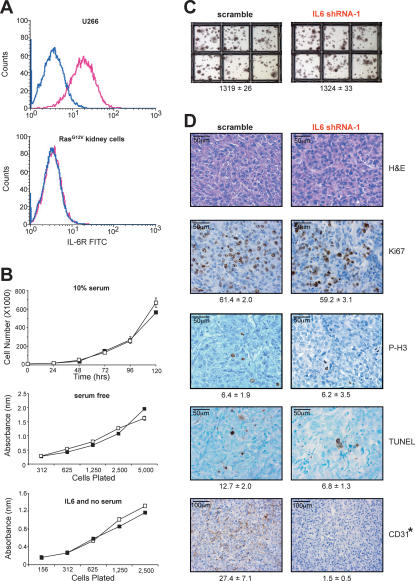Figure 3.
IL6 acts in a paracrine manner to promote angiogenesis. (A) Detection of IL6R (pink profile) by flow-cytometric analysis in positive control U266 cells (top graph), but not RasG12V-transformed human kidney cells (bottom graph). No antibody (blue profile) serves as a negative control. (B) IL6 does not alter the growth of RasG12V-transformed human kidney cells. Absorbance ± standard error versus time (days) as measured by the MTT assay of RasG12V-transformed human kidney cells stably expressing IL6 shRNA-1 (black box) or the appropriate scramble sequence (open box) cultured in 10% serum (top) or serum-free (middle) medium, or the same kidney cells lacking RasG12V plated at the indicated densities in serum-free medium (black box) or serum-free medium containing 100 pg/mL IL6 (open box). (C) Similar anchorage-independent growth of RasG12V-transformed human kidney cells stably expressing IL6 shRNA-1 versus the appropriate scramble sequence. Average number of colonies ± standard error calculated from three independent experiments conducted in triplicate. (D) Loss of IL6 inhibits angiogenesis. Tumors from RasG12V-transformed human kidney cells stably expressing IL6 shRNA-1 or the appropriate scramble sequence were excised, formalin-fixed, and stained for H&E or assayed for Ki67, phospho-histone H3 (P-H3), TUNEL, or CD31-positive (dark brown) cells. (Bottom) Average number of marker-positive cells ± standard deviation from five independent fields of two to four different tumors. (*) P < 0.01)

